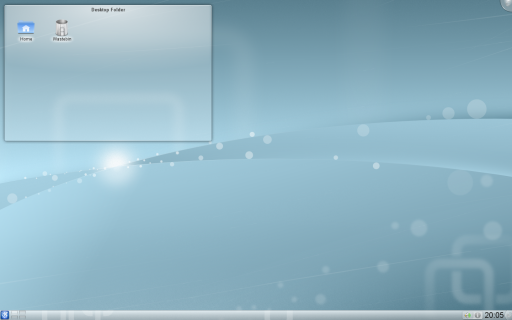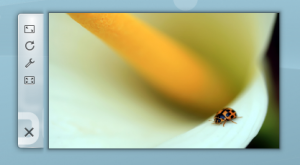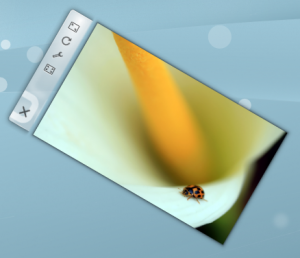Plasma/uk: Difference between revisions
Created page with 'На елементі керування розташовано три інструменти. Верхній з них призначено для зміни розмірів в...' |
Created page with 'Другий інструмент призначено для обертання віджета. Знову ж таки, наведіть на нього вказівник ми...' |
||
| Line 48: | Line 48: | ||
На елементі керування розташовано три інструменти. Верхній з них призначено для зміни розмірів віджета. Наведіть на нього вказівник миші, натисніть і утримуйте ліву кнопку миші, а потім перетягніть вказівник, щоб змінити розмір віджета. | На елементі керування розташовано три інструменти. Верхній з них призначено для зміни розмірів віджета. Наведіть на нього вказівник миші, натисніть і утримуйте ліву кнопку миші, а потім перетягніть вказівник, щоб змінити розмір віджета. | ||
Другий інструмент призначено для обертання віджета. Знову ж таки, наведіть на нього вказівник миші, натисніть і утримуйте ліву кнопку миші, а потім перетягніть вказівник, щоб обернути віджет. | |||
[[Image:Handle_rotate.png|300px|center]] | [[Image:Handle_rotate.png|300px|center]] | ||
Revision as of 14:58, 29 July 2010
Template:I18n/Language Navigation Bar
Вступ: для чого призначено і для чого не призначено Плазму
Плазма є комплексом програм, що забезпечує роботу інтерфейсу стільниці KDE 4, зокрема інструменту запуску програм (меню запуску), стільниці і панелі стільниці (яку часто просто називають панеллю задач).
Перший погляд на Плазму
Типова стільниця Плазми виглядає так:

Трьома ключовими компонентами стільниці Плазми є:
- Панель, відома як панель задач, на якій розташовано інструмент для запуску програм, список завдань, годинник і системний лоток;
- Стільниця, область, де розташовано віджети (піктограми і аплети);
- Панель інструментів Плазми у правому верхньому куті екрана, яку ще називають горішком. Такий самий горішок розташовано на панелі.
Знайомимося з Плазмою
Плазмою можна користуватися у той самий спосіб, у який ви користуєтеся стільницею будь-якої іншої операційної системи: ви можете запускати програми з меню програм (K-меню), переглядати поточний список запущених програм на панелі задач, працювати з піктограмами у системному лотку тощо.
Важливою частиною Плазми є так звані віджети. Віджети — це окремі модулі стільниці, до віджетів належать меню програм, піктограми, системний лоток, годинник... Віджети можна розташовувати на стільниці або додавати на панель. Панелі і стільниці є особливими різновидами віджетів, призначеними для розташування інших віджетів (у термінах Плазми їх називають «контейнерами»).
Як все це пов’язано з користуванням стільницею? У Плазмі передбачено декілька нових можливостей порівняно з традиційним використанням стільниці. Ми вже згадували про «горішки»: за їх допомогою можна керувати і налаштовувати Плазму. Якщо ви наведете на один з них вказівник миші і клацнете лівою кнопкою миші, система відкриє меню, у якому ви зможете обрати одну з дій: додавання віджетів на панель або стільницю, зміну розмірів, додавання або вилучення панелей та інші дії.
Стільниця і піктограми
Як ви можете зауважити з наведеного знімка вікна, на стільниці немає безпосередньо розташованих піктограм. Ці піктограми розташовано у контейнері, який називається «Переглядом тек». Подібна конструкція має декілька технічних причин, але, окрім цього, перегляд тек може чудово замінити собою стільницю (фактично, у цьому віджеті типово показано вміст теки стільниці). Ви можете перетягувати піктограми на віджет перегляду тек, вирізати, копіювати, вставляти, перейменовувати файли, а також створювати нові теки/файли.
Загалом кажучи, існує дві основні відмінності від звичайної теки стільниці:
- Ви можете створювати декілька переглядів тек на одній стільниці;
- Ви можете налаштовувати перегляд тек на показ різних тек (локальних і мережевих).
Окрім перегляду тек, ви можете розташовувати на стільниці будь-які віджети, зокрема віджет прогнозу погоди, віджети нотаток, перегляду файлів... Не існує ніяких меж подальшому налаштуванню.
Віджети повсюди
У KDE 3 ми звикли бачити аплети. У KDE 4 є віджети і плазмоїди. У чому ж відмінність? Гаразд, віджети — це загальний термін, яким описують не лише звичайні плазмоїди, але і інструменти з інших джерел, зокрема Google Gadgets. Додаткові віджети можна знайти і встановити за допомогою Get Hot New Stuff.
Віджети, які можна розташувати на панелі, зазвичай мають меню «Параметри», налаштування ж віджетів стільниці виконується за допомогою 'елемента керування', затіненої області, яка з’являється праворуч або ліворуч від віджета. Якщо ви наведете вказівник миші на порожню частину елемента керування і перетягнете вказівник, утримуючи натиснутою ліву кнопку миші, ви зможете перетягти віджет у потрібну вам позицію.

На елементі керування розташовано три інструменти. Верхній з них призначено для зміни розмірів віджета. Наведіть на нього вказівник миші, натисніть і утримуйте ліву кнопку миші, а потім перетягніть вказівник, щоб змінити розмір віджета.
Другий інструмент призначено для обертання віджета. Знову ж таки, наведіть на нього вказівник миші, натисніть і утримуйте ліву кнопку миші, а потім перетягніть вказівник, щоб обернути віджет.

The third is the wrench or spanner which allows you to configure that particular widget's settings.
Finally, the forth tool is used on some widgets like the Picture Frame. If you use the Picture Frame widget for example, it will open the image viewer.
Some of our favourite widgets are discussed on the Plasma Widgets page
Start menus etc.
The Panel

The panel can be configured by clicking on the toolbox on the right of the panel which puts the panel into configure mode. This lets you configure the panel to fit your needs.
Panel Alignment: Allows the alignment of the panel to be set in three pre-set positions.
Always Visible: Keeps the panel visible at all times, even when windows are maximised.
Auto Hide: Hides the panel off screen until the mouse is placed near the screen edge.
Windows can cover: This allows windows to cover the panel and if maximised, will cover the panel.
Windows go below: This allows windows to go below the panel, even when maximised.
Maximise Panel: Makes the panel fit to the screen edges, if it has been resized.
Remove this panel: Removes the current panel.
Lock Widgets: Locks the panel and widgets in position.
Add Spacer: Allows you to add a spacer into the panel giving space between the items in it.
Add Widgets: Allows widgets to be added to the panel.
Height: Allows the panel height to be adjusted.
Screen Edge: Allows you to drag the panel to any of the four edges of the screen.

The arrows on the edge, just below the main settings allow the panel's size to be adjusted. Dragging the arrow makes the panel smaller or larger. Dragging the arrow pointing down, moves the panel's position.
Advanced usage
Special cases not covered here
Activities and the Zooming User Interface (ZUI)
KDE Plasma has brought a lot of new features to the modern linux desktop, however many people are only using a fraction of the desktop's full potential. One of the most useful and underused features is the plasma activities. The basic idea behind is that your desktop space is limited to how many widgets it can hold. A user will want to use a lot of widgets but doesn't want their desktop to be cluttered. The answer to this problem is activities; they allow you to specialize each desktop to whatever task you need to accomplish. To make a new activity you have to click on the toolbox in the upper right hand corner, from there click zoom out. The desktop will zoom out then click add new activity under the small desktop. It will make a new desktop right next to it. Now go click the zoom in button under the new desktop. With this desktop you can add whatever widgets to this desktop and it will not affect the other desktop.
Activities and Virtual Desktops
Virtual desktops, the ability to have a separate sets of windows on separate desktops, can tie in with Activities. You can have a different activity on each virtual desktop. In Plasma Desktop 4.4, this can be configured by entering System Settings and navigating to Desktop -> Multiple Desktops, and checking "Different Activity for Each Desktop".
In Plasma Desktop 4.3, You configure this by zooming out and choosing "configure Plasma". Then select "use a different activity on each desktop" and zoom in again.
Use Cases
A user likes web comics so they add their favorite web comics via the comics widget. The user now has a full desktop activity dedicated to their favorite web comics. Now the user is happy with the web comics, but the user now has to go to work, so the user creates a activity with the folder view widgets set to the folders of the projects the user is currently working on. After work the user goes home and works on a side project of writing romance novels. The user always gains inspiration by looking at pictures of the user's significant other. The user now creates a new Activity but now puts pictures frame widgets with pictures of the user's significant other. The user also has a folder view of the romance novel project folder. Now no matter what the user is doing the user has a custom tailored activity to match it.
Go to this blog to read a few tips on using activities.
Hints and Tips
The Taskbar
Accessing the Taskbar Settings Menu: Click the panel toolbox (aka cashew), then right-click on the taskbar. From there you can access the Taskbar Settings dialog. The following settings are particularly useful:
- Grouping and Sorting: Grouping can be by program name, manually, or not at all. (You can also choose to only enable grouping if the taskbar is full.) Similarly, Sorting defaults to alphabetically, but it can also be by desktop, manually, or not sorted.
- Only Show Tasks from the Current Desktop: A checkbox on the Filters section.
- Have More than One Row on the Taskbar: If you use many applications at one time you may find it advantageous to set Maximum Rows and then Force Row Settings.
- Showing or Hiding Tooltips: A simple checkbox in the Appearance section of the General page.
Tweaking Plasma
- Learn how to add a sidebar with clock and news
- Customize your Plasma by mixing multiple Plasma themes
Further information
- The Plasma FAQ
- Plasma HowTo - short screencasts
- Glossary
- Some of our favourite plamoids - why not add yours?
- Here's how to install more Plasmas widgets
- Learn the versatility of KRunner
| Back to the Introduction page |

